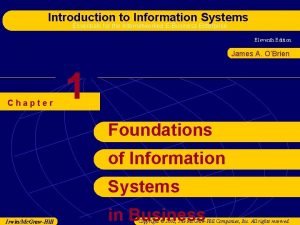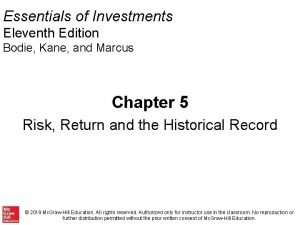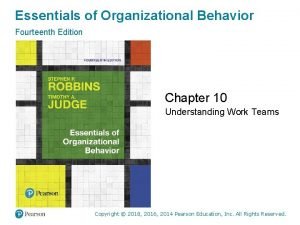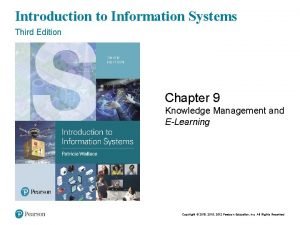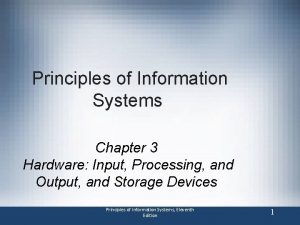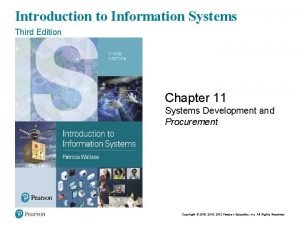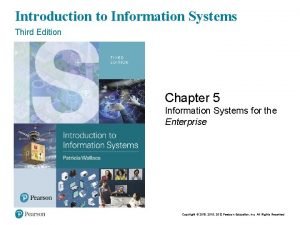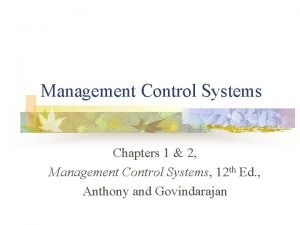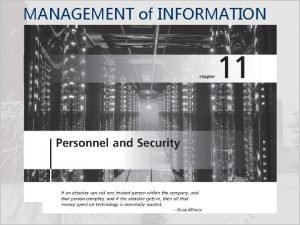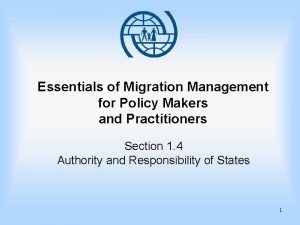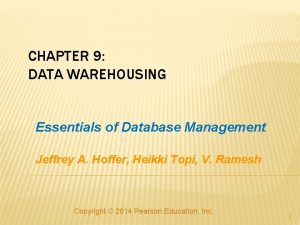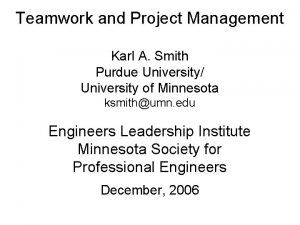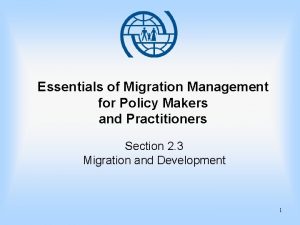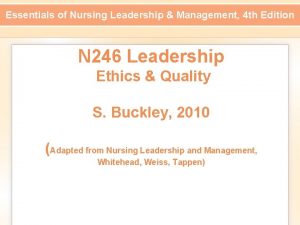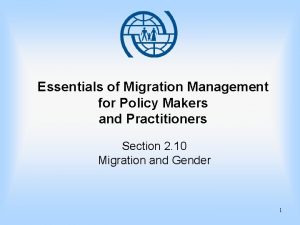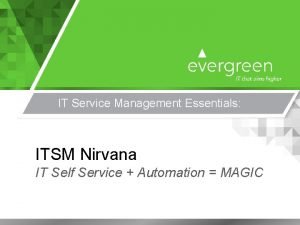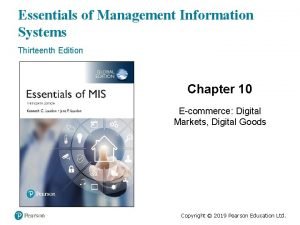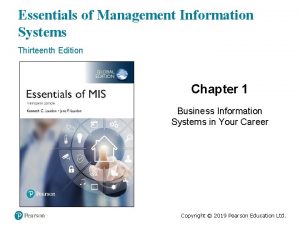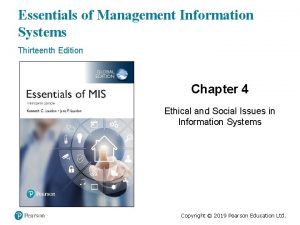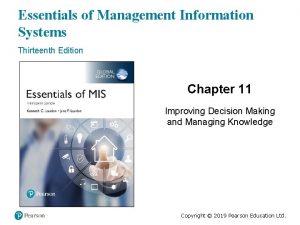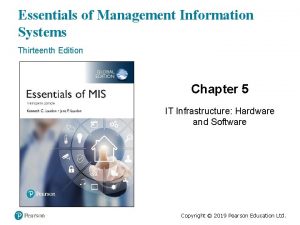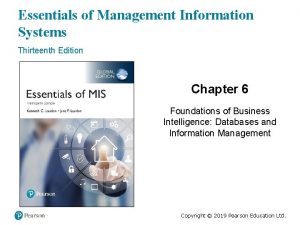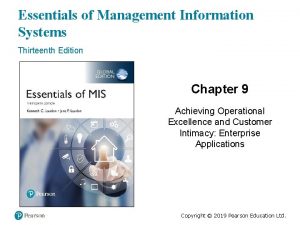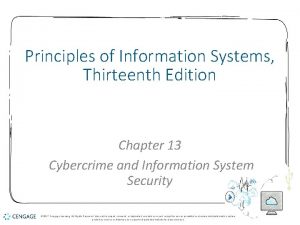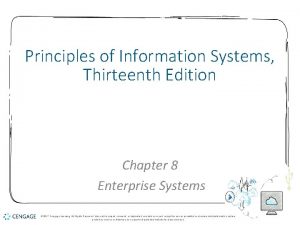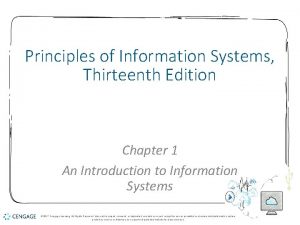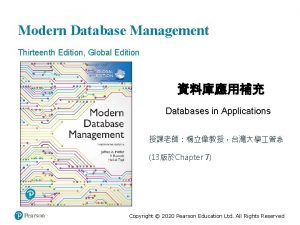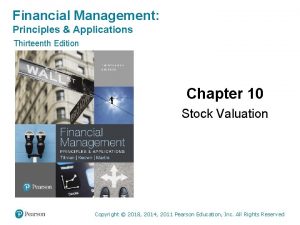Essentials of Management Information Systems Thirteenth Edition Chapter














































- Slides: 46

Essentials of Management Information Systems Thirteenth Edition Chapter 2 Global E-business and Collaboration Copyright © 2019 Pearson Education Ltd.

Learning Objectives 2. 1 What major features of a business are important for understanding the role of information systems? 2. 2 How do systems serve different management groups in a business, and how do systems that link the enterprise improve organizational performance? 2. 3 Why are systems for collaboration and social business so important, and what technologies do they use? 2. 4 What is the role of the information systems function in a business? 2. 5 How will MIS help my career? Copyright © 2019 Pearson Education Ltd.

Video Cases • Case 1: Walmart’s Retail Link Supply Chain • Case 2: CEMEX – Becoming a Social Business • Instructional Video 1: US Foodservice Grows Market with Oracle CRM on Demand Copyright © 2019 Pearson Education Ltd.

Enterprise Social Networking Helps Sanofi Pasteur Innovate and Improve Quality (1 of 2) • Problem – Hierarchical top-down processes – Large geographically dispersed workforce • Solutions – Develop knowledge-sharing strategy and goals – Redesign knowledge and collaboration processes – Microsoft Yammer – Enterprise social networking Copyright © 2019 Pearson Education Ltd.

Enterprise Social Networking Helps Sanofi Pasteur Innovate and Improve Quality (2 of 2) • Use of new technology to engage employees and enabled knowledge gathering and sharing • Demonstrates how outdated processes can affect knowledge sharing and innovation • Illustrates why organizations rely on information systems to improve performance and remain competitive Copyright © 2019 Pearson Education Ltd.

Organizing a Business: Basic Business Functions (1 of 2) • Business: formal organization that makes products or provides a service in order to make a profit • Four basic business functions – Manufacturing and production – Sales and marketing – Finance and accounting – Human resources Copyright © 2019 Pearson Education Ltd.

Organizing a Business: Basic Business Functions (2 of 2) • Five basic business entities – Suppliers – Customers – Employees – Invoices/payments – Products and services Copyright © 2019 Pearson Education Ltd.

Figure 2. 1 The Four Major Functions of a Business Copyright © 2019 Pearson Education Ltd.

Business Processes • Logically related set of tasks that define how specific business tasks are performed – The tasks each employee performs, in what order, and on what schedule – E. g. , Steps in hiring an employee • Some processes tied to functional area – Sales and marketing: identifying customers • Some processes are cross-functional – Fulfilling customer order Copyright © 2019 Pearson Education Ltd.

Figure 2. 2 The Order Fulfillment Process Copyright © 2019 Pearson Education Ltd.

How IT Enhances Business Processes • Automation of manual processes • Change the flow of information • Replace sequential processes with simultaneous activity • Transform how a business works • Drive new business models Copyright © 2019 Pearson Education Ltd.

Managing a Business and Firm Hierarchies • Firms coordinate work of employees by developing hierarchy in which authority is concentrated at top. – Senior management – Middle management – Operational management – Knowledge workers – Data workers – Production or service workers • Each group has different needs for information. Copyright © 2019 Pearson Education Ltd.

Figure 2. 3 Levels in a Firm Copyright © 2019 Pearson Education Ltd.

The Business Environment • Businesses depend heavily on their environments for capital, labor, supplies, and more. • Global environment – Technology and science, economy, politics, international change • Immediate environment – Customers, suppliers, competitors, regulations, stockholders Copyright © 2019 Pearson Education Ltd.

Figure 2. 4 The Business Environment Copyright © 2019 Pearson Education Ltd.

The Role of Information Systems in a Business • Firms invest in information systems in order to: – Achieve operational excellence – Develop new products and services – Attain customer intimacy and service – Improve decision making – Promote competitive advantage – Ensure survival Copyright © 2019 Pearson Education Ltd.

Systems for Different Management Groups • Transaction processing systems (TPS) – Keep track of basic activities and transactions of organization • Systems for business intelligence – Address decision-making needs of all levels of management ▪ Management information systems (MIS) ▪ Decision support systems (DSS) ▪ Executive support systems (ESS) Copyright © 2019 Pearson Education Ltd.

Transaction Processing Systems • Serve operational managers • Principal purpose is to answer routine questions and to track the flow of transactions through the organization – E. g. , inventory questions, granting credit to customer • Monitor status of internal operations and firm’s relationship with external environment • Major producers of information for other systems • Highly central to business operations and functioning Copyright © 2019 Pearson Education Ltd.

Figure 2. 5 A Payroll TPS Copyright © 2019 Pearson Education Ltd.

Management Information Systems • Provide middle managers with reports on firm’s performance, to help monitor firm and predict future performance • Summarize and report on basic operations using data from TPS • Provide weekly, monthly, annual results, but may enable drilling down into daily or hourly data • Typically not very flexible systems with little analytic capability Copyright © 2019 Pearson Education Ltd.

Figure 2. 6 How MIS Obtain Their Data from the Organization’s TPS Copyright © 2019 Pearson Education Ltd.

Figure 2. 7 Sample MIS Report Copyright © 2019 Pearson Education Ltd.

Decision Support Systems • Serve middle managers • Support nonroutine decision making – Example: What is impact on production schedule if December sales doubled? • Often use external information as well from TPS and MIS • Model driven DSS – Voyage-estimating systems • Data driven DSS – Intrawest’s marketing analysis systems Copyright © 2019 Pearson Education Ltd.

Figure 2. 8 Voyage-Estimating Decision Support System Copyright © 2019 Pearson Education Ltd.

Executive Support Systems • Serve senior managers • Address strategic issues and long-term trends – E. g. , what products should we make in five years? • Address nonroutine decision making • Provide generalized computing capacity that can be applied to changing array of problems • Draw summarized information from MIS, DSS, and data from external events • Typically use portal with Web interface, or digital dashboard, to present content Copyright © 2019 Pearson Education Ltd.

Figure Digital Dashboard Copyright © 2019 Pearson Education Ltd.

Interactive Session – People: Data Changes How NFL Teams Play the Game and How Fans See it • Class discussion – What kinds of systems are illustrated in this case study? Where do they obtain their data? What do they do with the data? Describe some of the inputs and outputs of these systems. – What business functions do these systems support? Explain your answer. – How do the data about teams and players captured by the N FL help NFL football teams and the NFL itself make better decisions? Give examples of two decisions that were improved by the systems described in this case. – How did using data help the NFL and its teams improve the way they run their business? Copyright © 2019 Pearson Education Ltd.

Systems for Linking the Enterprise • Enterprise applications – Systems that span functional areas, focus on executing business processes across the firm, and include all levels of management • Four major types – Enterprise systems – Supply chain management systems – Customer relationship management systems – Knowledge management systems Copyright © 2019 Pearson Education Ltd.

Figure 2. 9 Enterprise Application Architecture Copyright © 2019 Pearson Education Ltd.

Enterprise Systems • Also called enterprise resource planning (ERP) systems • Integrate data from key business processes into single system • Speed communication of information throughout firm • Enable greater flexibility in responding to customer requests, greater accuracy in order fulfillment • Enable managers to assemble overall view of operations Copyright © 2019 Pearson Education Ltd.

Supply Chain Management (SCM) Systems • Manage relationships with suppliers, purchasing firms, distributors, and logistics companies • Manage shared information about orders, production, inventory levels, and so on – Goal is to move correct amount of product from source to point of consumption as quickly as possible and at lowest cost • Type of interorganizational system – Automating flow of information across organizational boundaries Copyright © 2019 Pearson Education Ltd.

Customer Relationship Management (C RM) Systems • Help manage relationship with customers. • Coordinate business processes that deal with customers in sales, marketing, and customer service • Goals: – Optimize revenue – Improve customer satisfaction – Increase customer retention – Identify and retain most profitable customers – Increase sales Copyright © 2019 Pearson Education Ltd.

Knowledge Management Systems • Manage processes for capturing and applying knowledge and expertise • Collect relevant knowledge and make it available wherever needed in the enterprise to improve business processes and management decisions • Link firm to external sources of knowledge Copyright © 2019 Pearson Education Ltd.

Intranets and Extranets • Technology platforms that increase integration and expedite the flow of information • Intranets: – Internal networks based on Internet standards – Often are private access area in company’s website • Extranets: – Company websites accessible only to authorized vendors and suppliers – Facilitate collaboration Copyright © 2019 Pearson Education Ltd.

E-Business, E-Commerce, and E-Government • E-business: – Use of digital technology and Internet to drive major business processes • E-commerce: – Subset of e-business – Buying and selling goods and services through Internet • E-government: – Using Internet technology to deliver information and services to citizens, employees, and businesses Copyright © 2019 Pearson Education Ltd.

What is Collaboration? • Growing importance of collaboration: – Changing nature of work – Growth of professional work – Changing organization of the firm – Changing scope of the firm – Emphasis on innovation – Changing culture of work and business Copyright © 2019 Pearson Education Ltd.

What is Social Business? • Use of social networking platforms to engage employees, customers, suppliers • Conversations to strengthen bonds • Requires information transparency • Seen as way to drive operational efficiency, spur innovation, accelerate decision making Copyright © 2019 Pearson Education Ltd.

Business Benefits of Collaboration and Social Business • Investment in collaboration technology can return large rewards, especially in sales and marketing, research and development • Productivity: Sharing knowledge and resolving problems • Quality: Faster resolution of quality issues • Innovation: More ideas for products and services • Customer service: Complaints handled more rapidly • Financial performance: Generated by improvements in factors above Copyright © 2019 Pearson Education Ltd.

Figure 2. 10 Requirements for Collaboration Copyright © 2019 Pearson Education Ltd.

Tools and Technologies for Collaboration and Teamwork • Email and instant messaging (IM) • Wikis • Virtual worlds • Collaboration and social business environments – Virtual meeting systems (telepresence) – Cloud collaboration services ▪ Google Drive, Dropbox – Microsoft Share. Point and IBM Notes – Enterprise social networking tools Copyright © 2019 Pearson Education Ltd.

Interactive Session – Technology: Collaborating the Glasscubes Way • Class discussion – Discuss the features of Glasscubes as a collaboration software. – Why did the NSHCS require a tool for collaboration? Was Glasscubes a feasible option? – Name some other areas where such software can be useful. Discuss at least one such area. Copyright © 2019 Pearson Education Ltd.

Evaluating and Selecting Collaboration Tools 1. What are your firm’s collaboration challenges? 2. What kinds of solutions are available? 3. Analyze available products’ cost and benefits. 4. Evaluate security risks. 5. Consult users for implementation and training issues. 6. Select candidate tools and evaluate vendors. Copyright © 2019 Pearson Education Ltd.

Figure 2. 11 The Time/Space Collaboration and Social Tool Matrix Copyright © 2019 Pearson Education Ltd.

The Information Systems Department • Programmers • Systems analysts – Principle liaisons to rest of firm • Information systems managers – Leaders of teams of programmers and analysts, project managers, physical facility managers, telecommunications managers, database specialists, managers of computer operations, and data entry staff • Senior managers: CIO, CPO, CSO, CKO, CDO • End users Copyright © 2019 Pearson Education Ltd.

Information Systems Services • Computing services • Telecommunications services • Data management services • Application software services • Physical facilities management services • IT standards services • IT educational services • IT research and development services Copyright © 2019 Pearson Education Ltd.

How Will MIS Help My Career? • The Company: Comprehensive Supplemental Insurance USA • Position Description • Job Requirements • Interview Questions Copyright © 2019 Pearson Education Ltd.
 Management information systems 13th edition
Management information systems 13th edition Management information systems 16th edition
Management information systems 16th edition Introduction to information systems 5th edition
Introduction to information systems 5th edition Business essentials 12th edition chapter 1
Business essentials 12th edition chapter 1 Essentials of information systems
Essentials of information systems Network security essentials 5th edition pdf
Network security essentials 5th edition pdf Essentials of investments 11th edition
Essentials of investments 11th edition Business essentials 12th edition free
Business essentials 12th edition free Essentials of sociology 5th edition
Essentials of sociology 5th edition Firefighter essentials 7th edition
Firefighter essentials 7th edition Business essentials 12th edition
Business essentials 12th edition Essentials of organizational behavior 14th edition
Essentials of organizational behavior 14th edition Essentials of firefighting 7th edition
Essentials of firefighting 7th edition Network security essentials 5th edition
Network security essentials 5th edition Criminal justice the essentials 5th edition
Criminal justice the essentials 5th edition Introduction to information systems 6th edition
Introduction to information systems 6th edition Fundamentals of information systems 9th edition
Fundamentals of information systems 9th edition Fundamentals of information systems 9th edition
Fundamentals of information systems 9th edition Principles of information systems
Principles of information systems Introduction to information systems 3rd edition
Introduction to information systems 3rd edition Information systems literacy
Information systems literacy Principles of information systems 11th edition
Principles of information systems 11th edition Fundamentals of information systems
Fundamentals of information systems Introduction to information systems 3rd edition
Introduction to information systems 3rd edition Fundamentals of information systems 9th edition
Fundamentals of information systems 9th edition Introduction to information systems 3rd edition
Introduction to information systems 3rd edition Management information system chapter 1
Management information system chapter 1 Introduction to mis
Introduction to mis Goal congruence in management control system
Goal congruence in management control system Information technology project management 9th edition
Information technology project management 9th edition Information technology project management 9th edition ppt
Information technology project management 9th edition ppt Management of information security 5th edition
Management of information security 5th edition Information technology project management 8th edition
Information technology project management 8th edition Information technology project management 9th edition
Information technology project management 9th edition Information technology project management 9th edition
Information technology project management 9th edition Essentials of systems analysis and design
Essentials of systems analysis and design Using mis (10th edition) 10th edition
Using mis (10th edition) 10th edition Zulily case study
Zulily case study Management robbins coulter
Management robbins coulter Essentials of migration management
Essentials of migration management Essentials of database management
Essentials of database management One purdue success factors
One purdue success factors Essentials of migration management
Essentials of migration management Values in nursing profession ppt
Values in nursing profession ppt Essentials of migration management
Essentials of migration management Service management essentials
Service management essentials Example of mis
Example of mis




